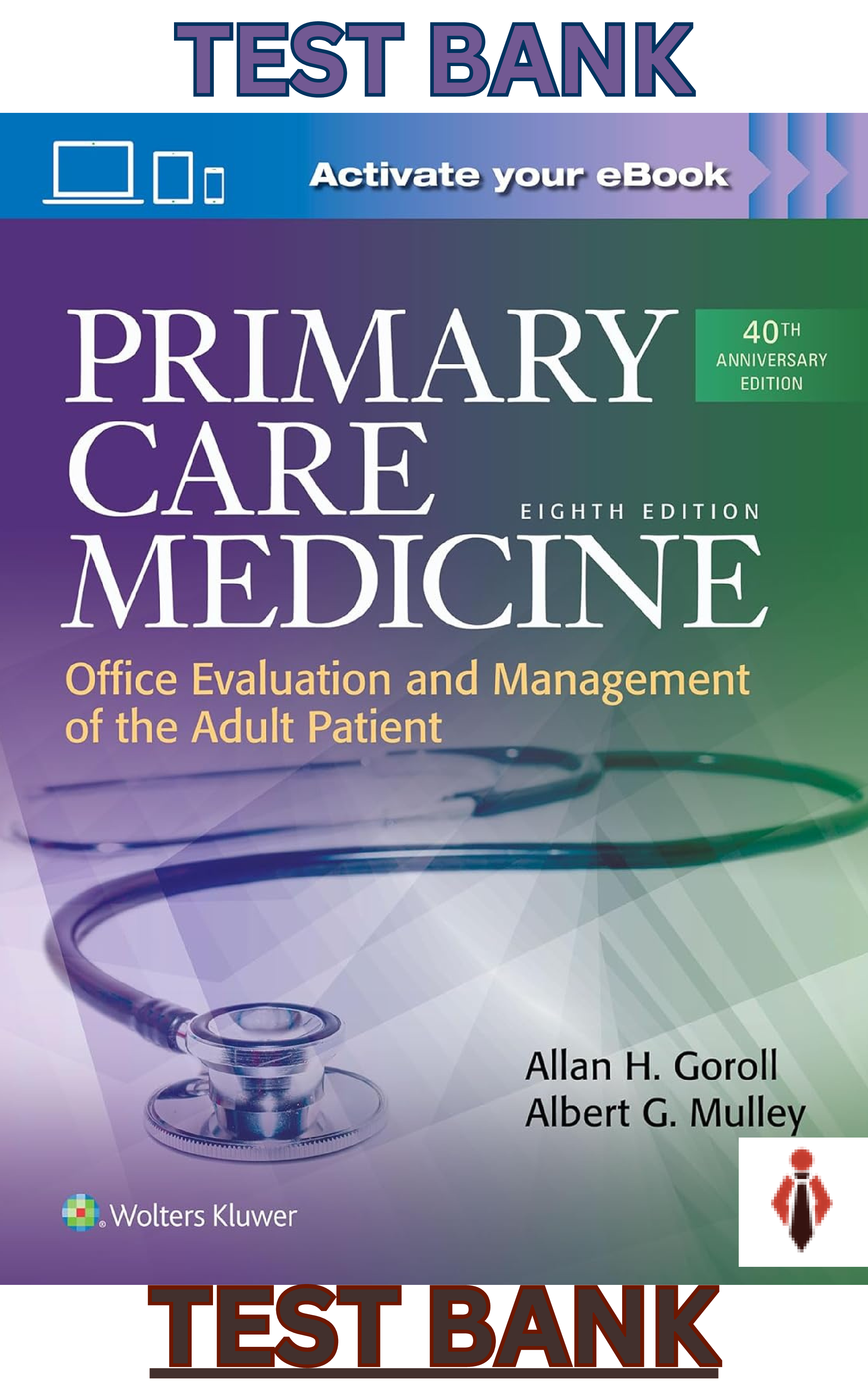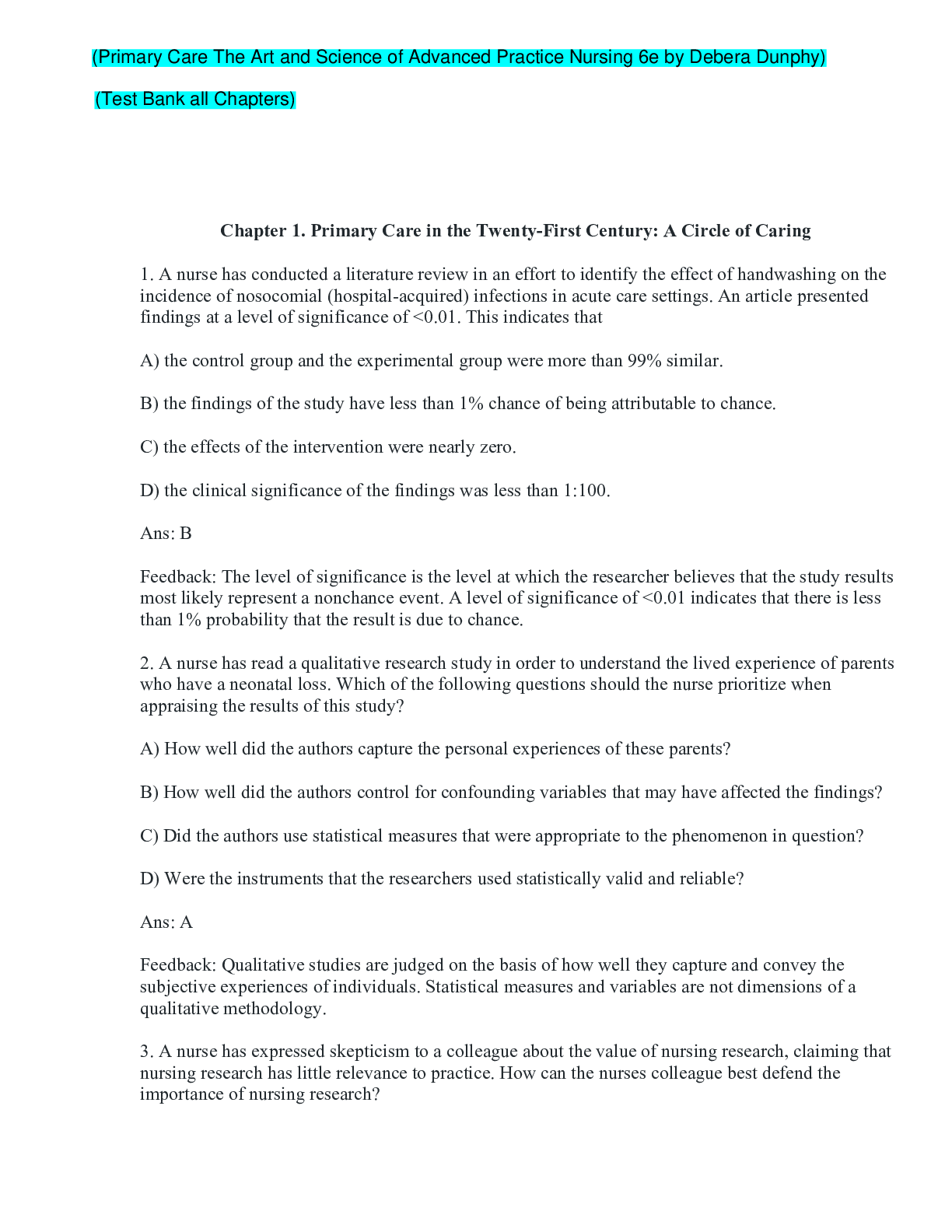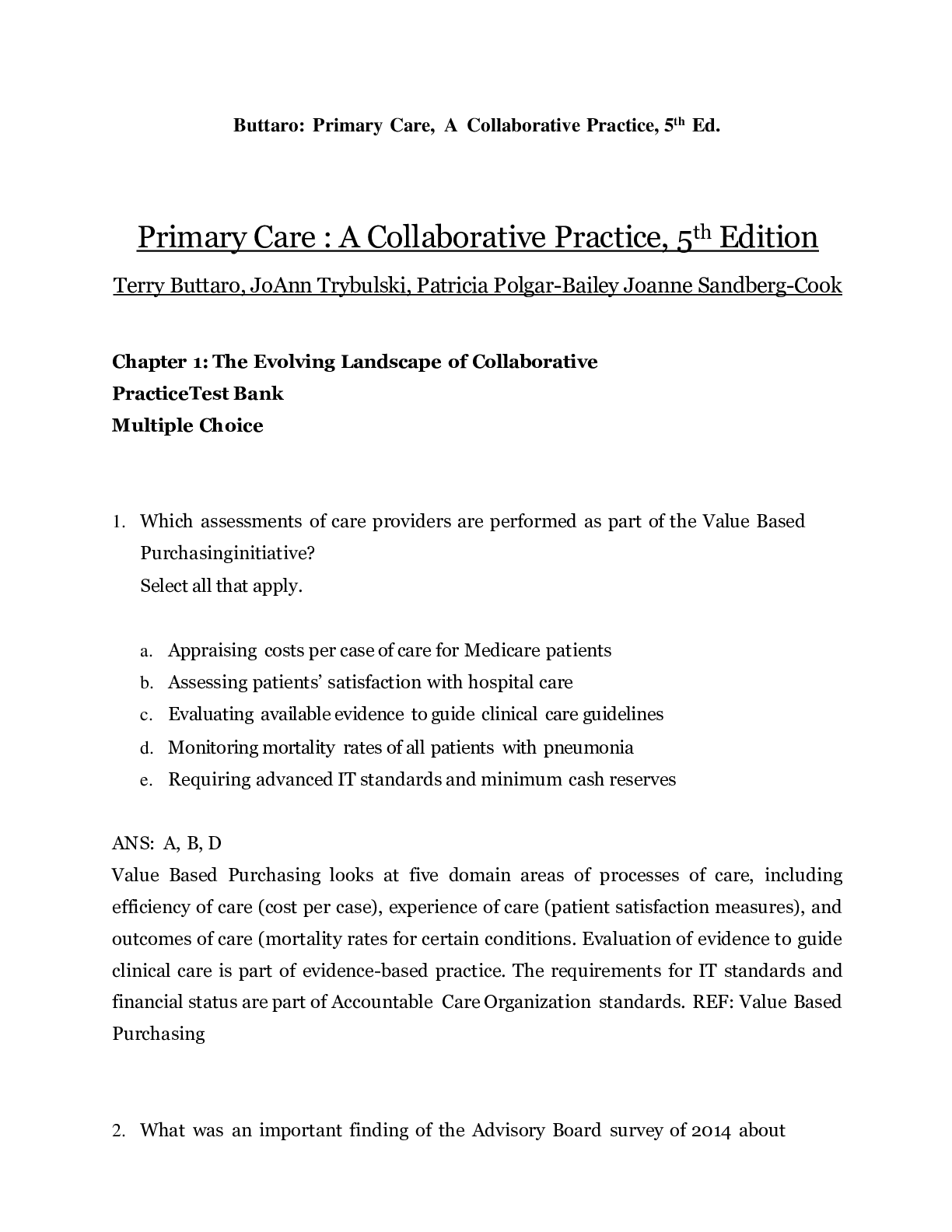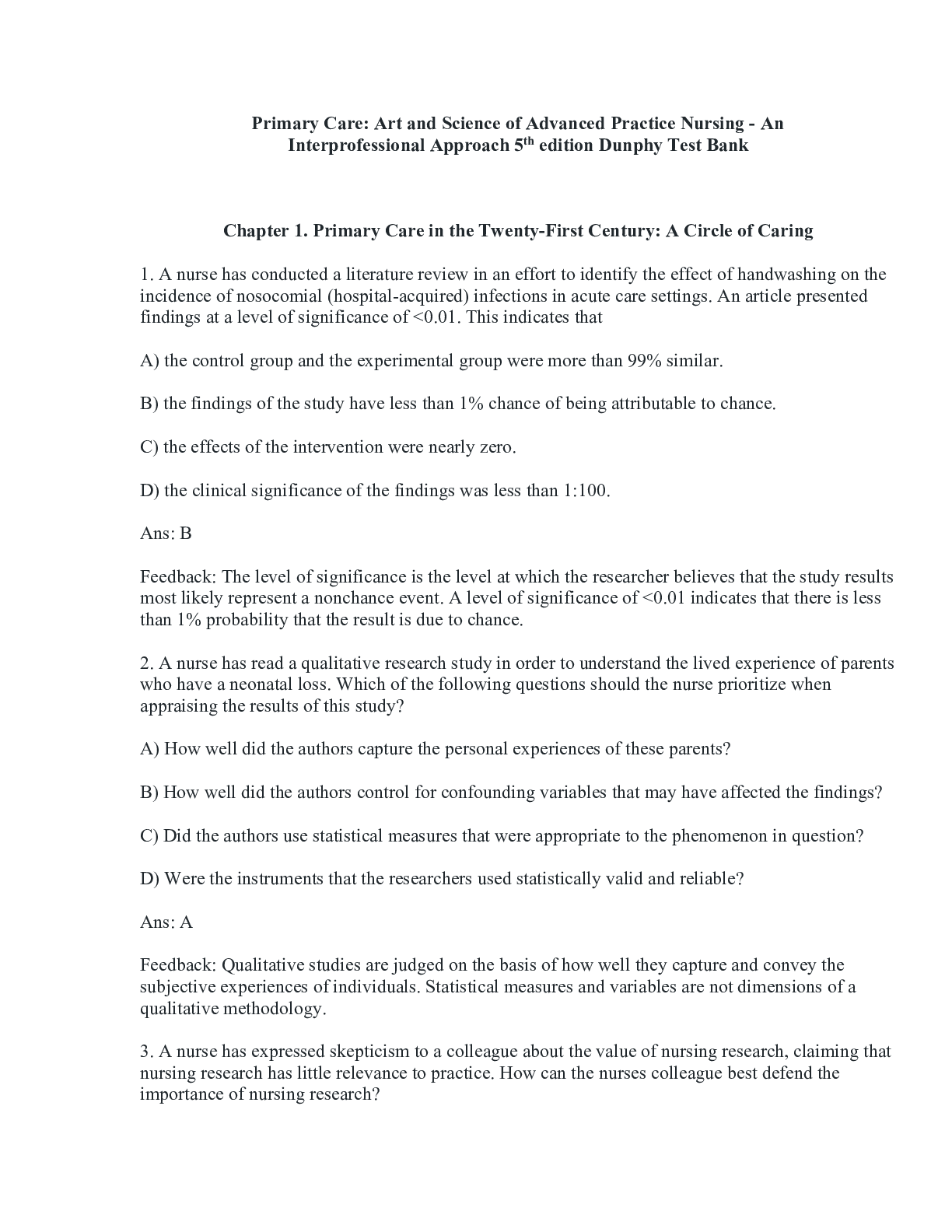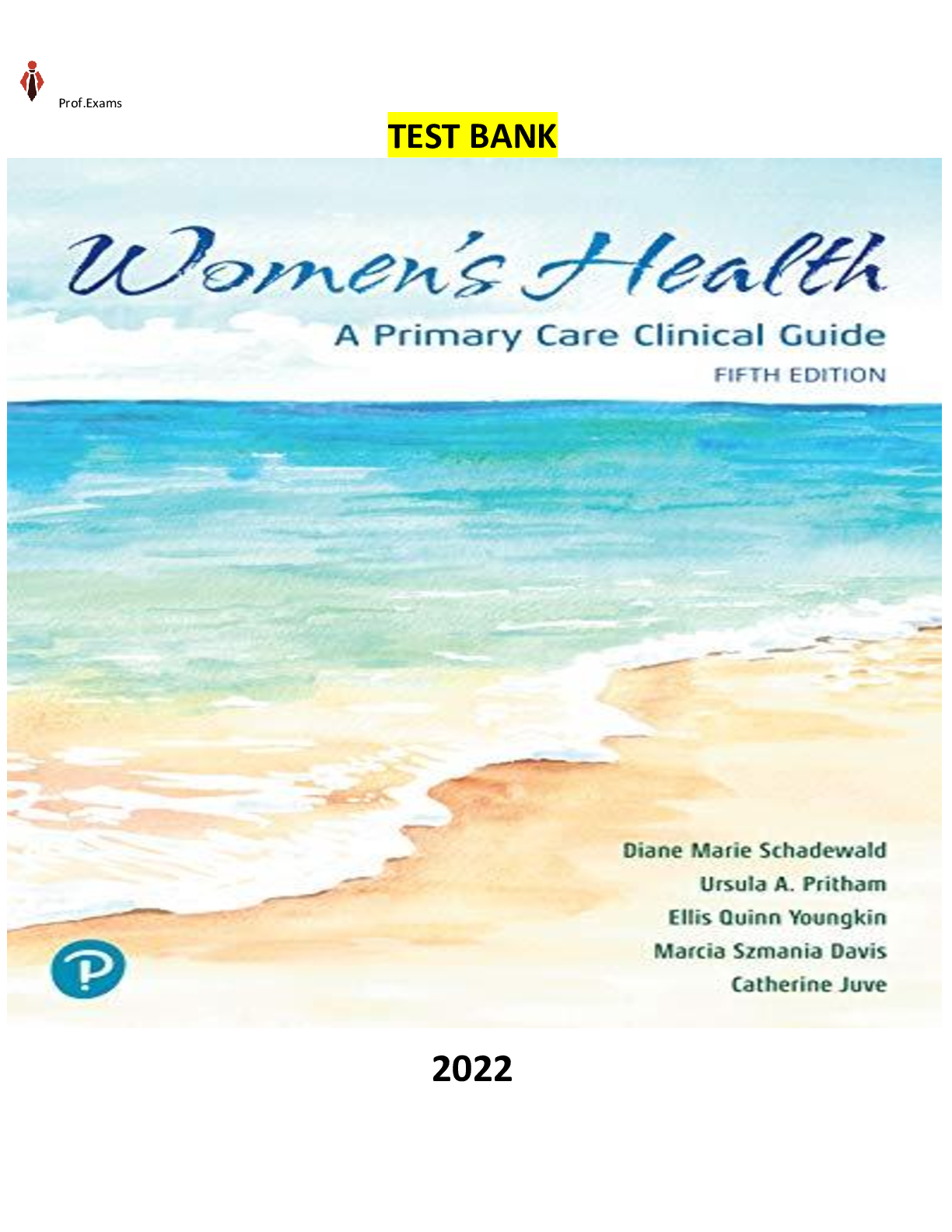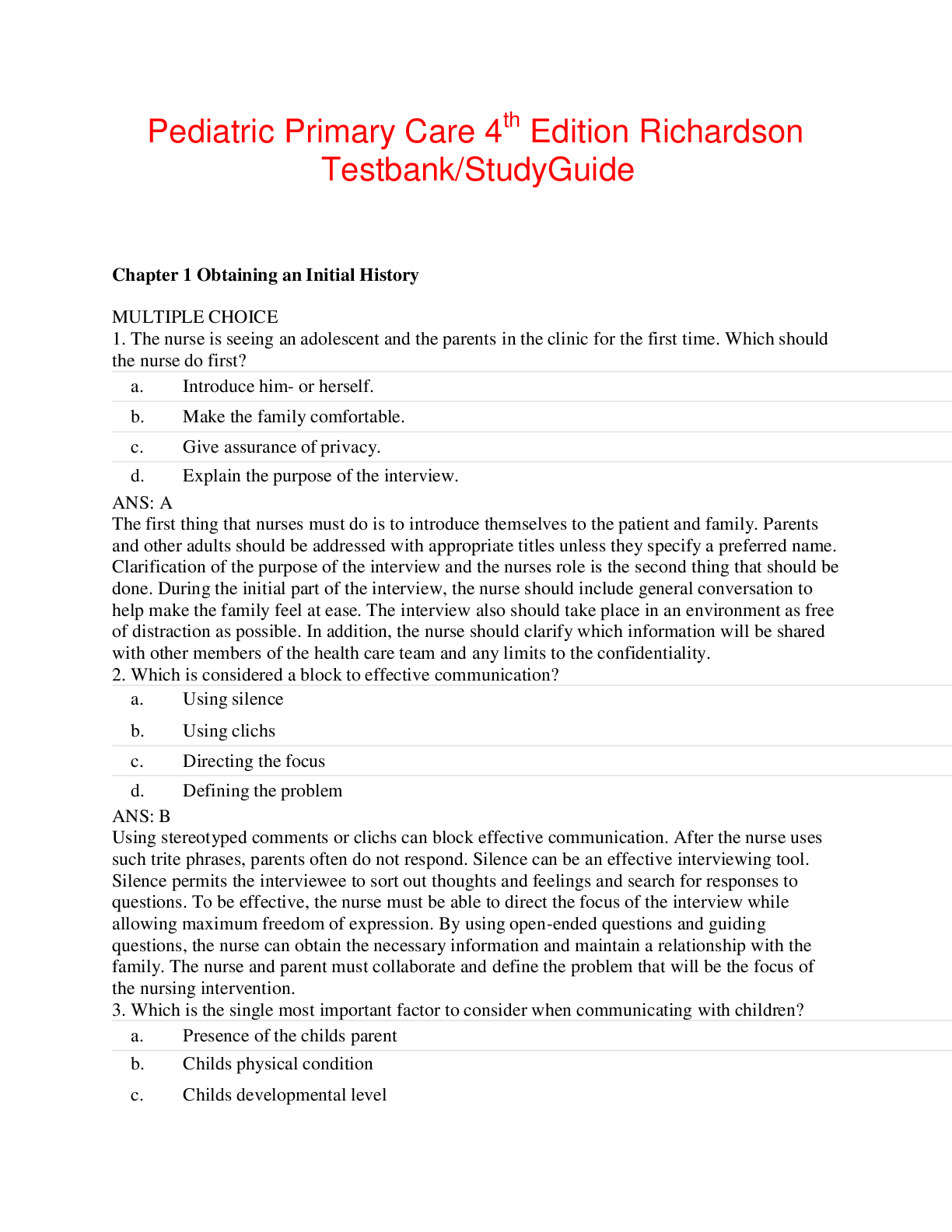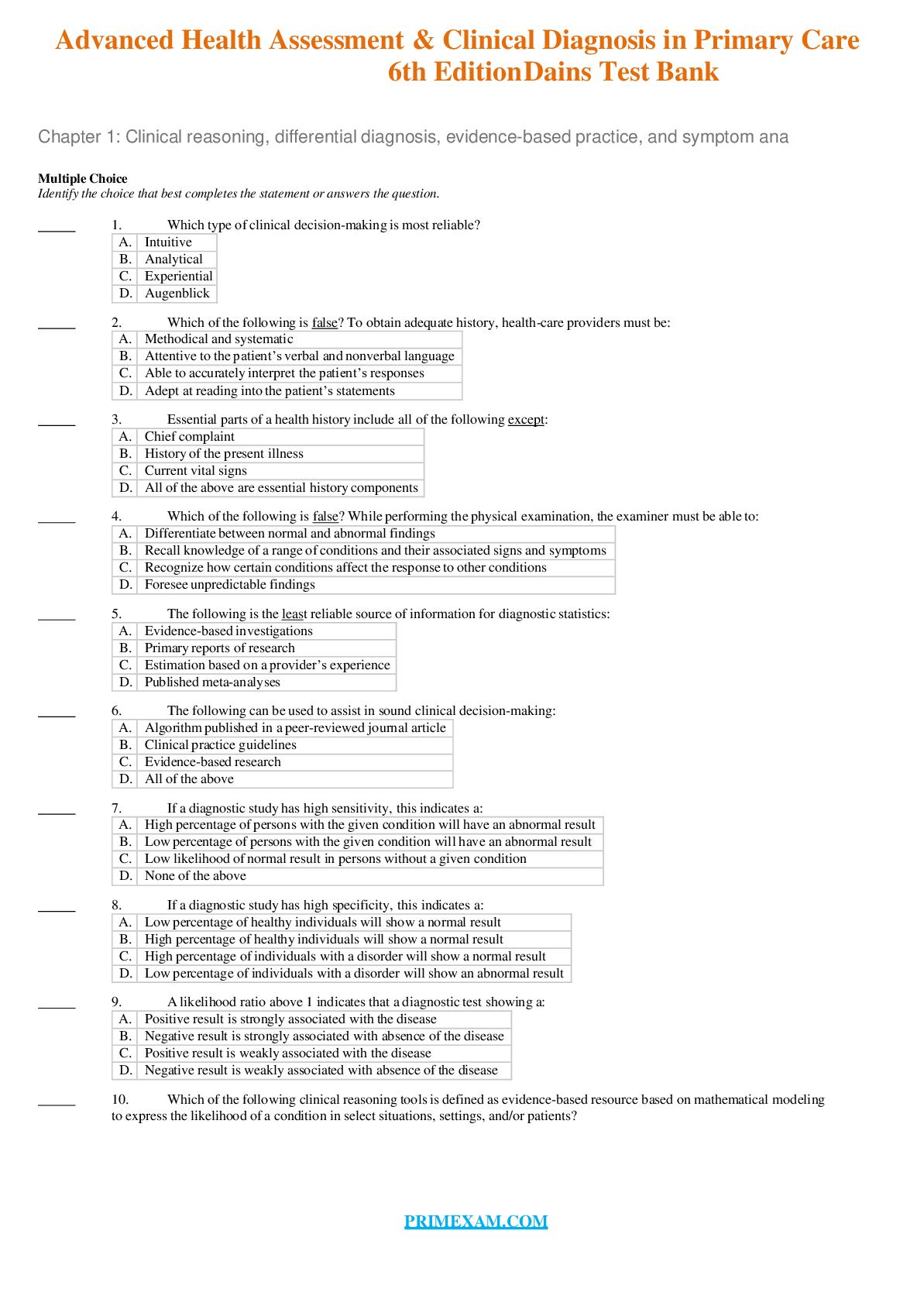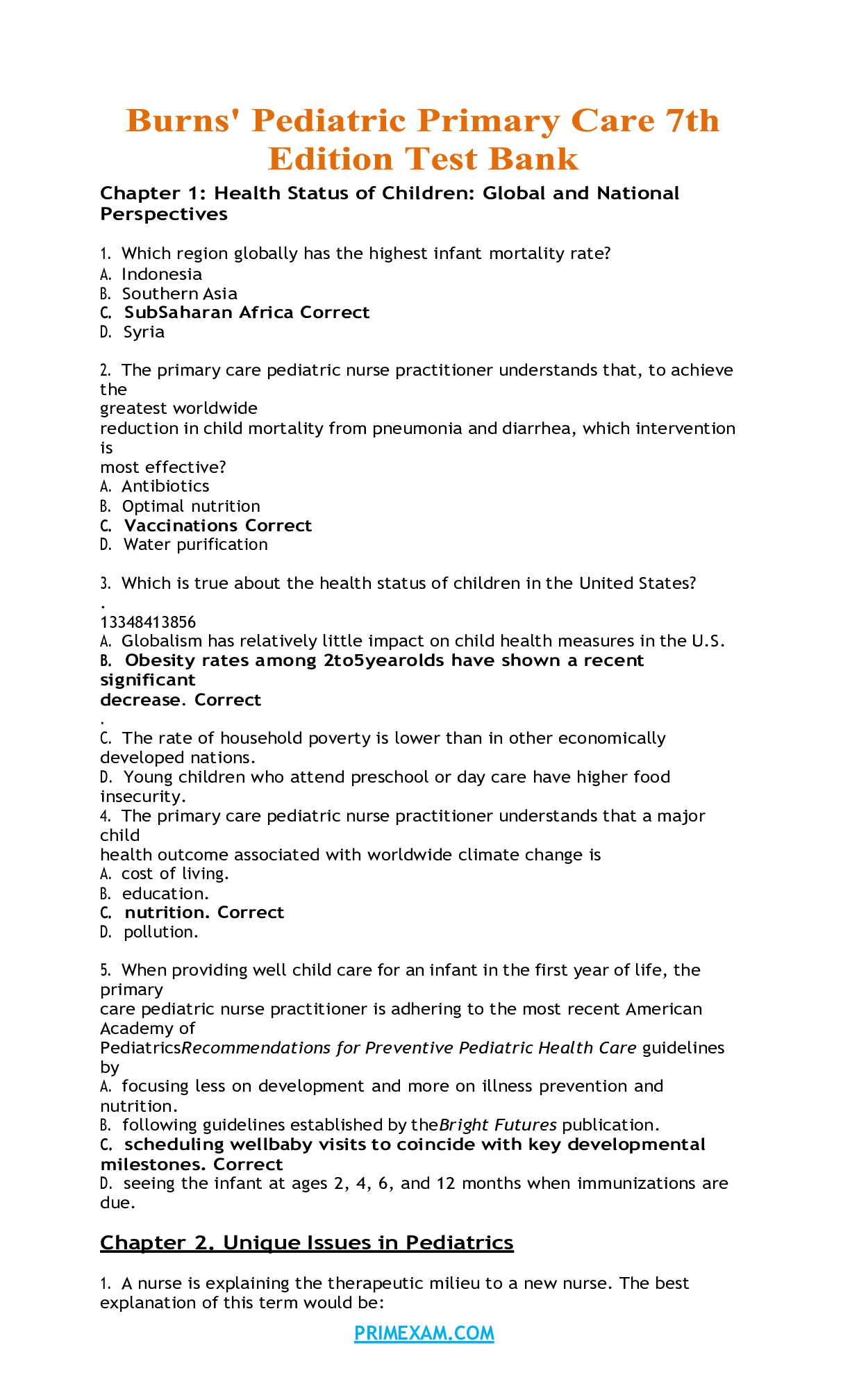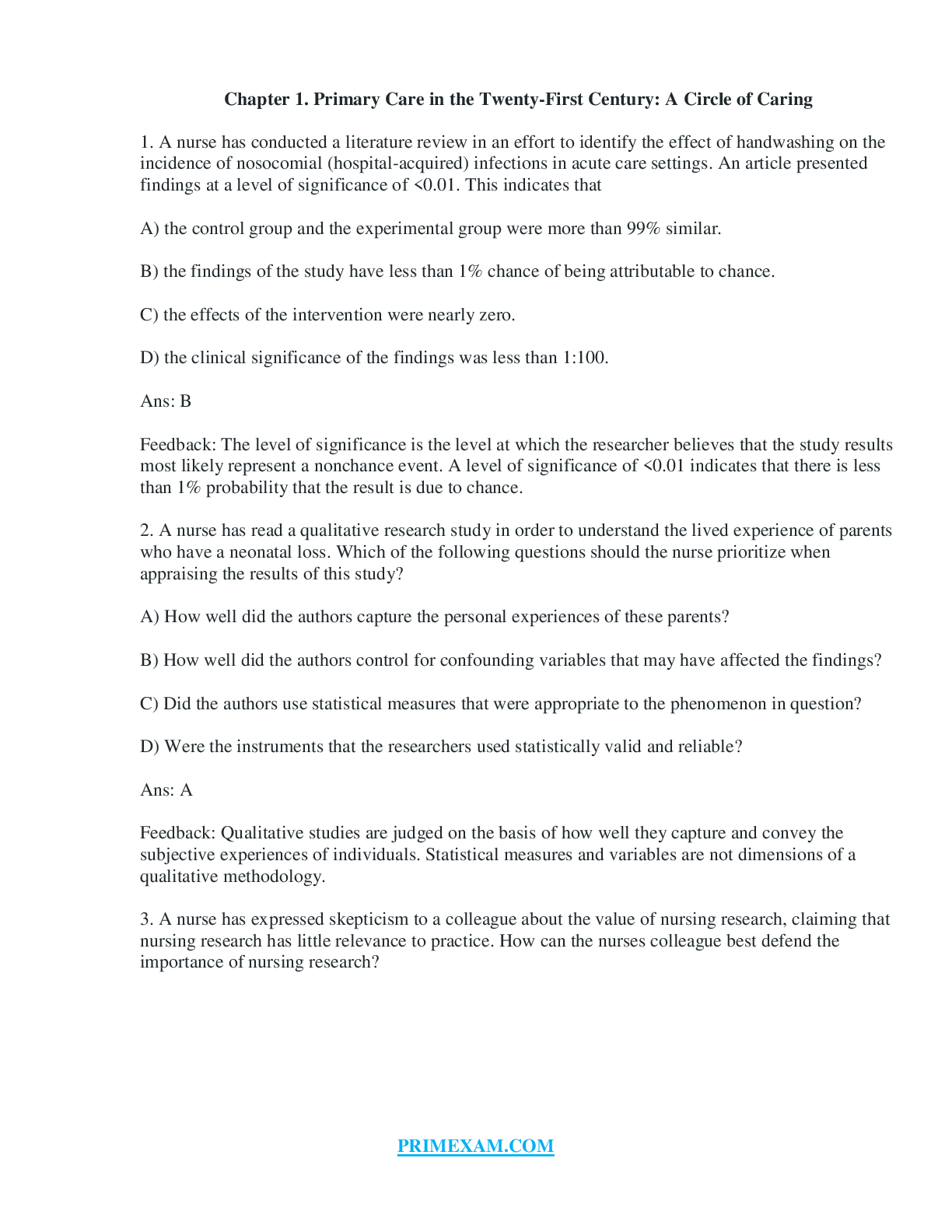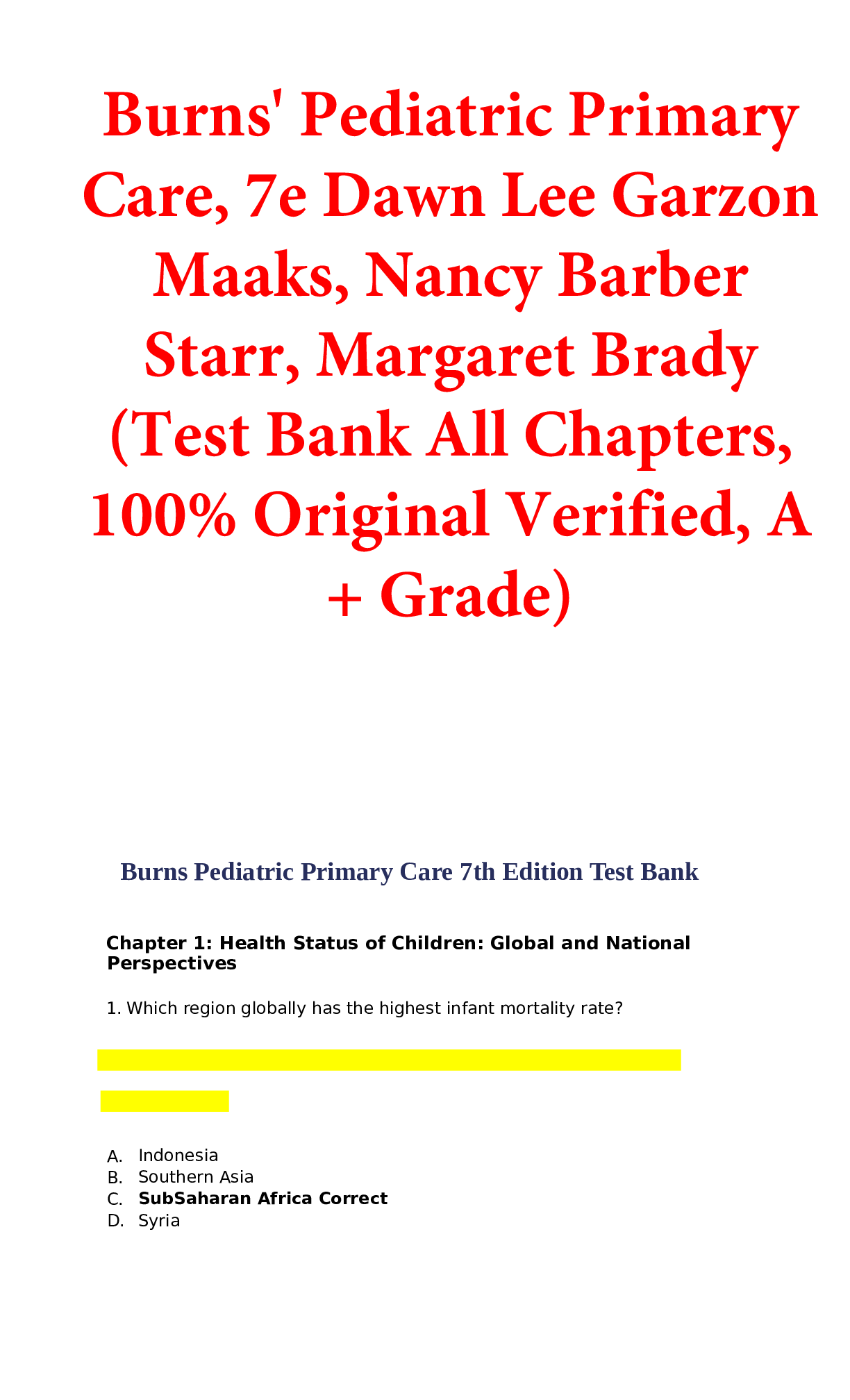*NURSING > TEST BANK > Test Bank For Burns' Pediatric Primary Care 7th Edition Maaks Starr Brady (All)
Test Bank For Burns' Pediatric Primary Care 7th Edition Maaks Starr Brady
Document Content and Description Below
Table of Contents Unit I. Influences on Child Health and Child Health Assessment 1. Health Status of Children: Global and National Perspectives Global Health Status of Children Progress on the Mil... lennium Development Goals Health Status of Children in the United States Food and Housing Insecurity and Effect on Children’s Health Addressing Children’s Health in the United States Adverse Childhood Events and Impact on Child Health Outcomes Role of Primary Care Providers for Improving Child Health 2. Unique Issues in Pediatrics Two-Generation or Dual Patient Looking Through a Developmental Lens Parents, Families, and Behavioral Economics Early Investment in Lifelong Health Health Literacy Transitioning to Adult Care 3. Genetics and Genomics : The Basics for Child Health Basic Principles of Genetics Genetics and Diseases Patterns of Inheritance Epigenetics Integration of Basic Genetics and Genomics into Pediatric Primary Care Ethical Issues 4. Environment and Child Health Introduction Principles for Understanding Children’s Environmental Health Children’s Increased Risk for Environment-Related Illness Approach to Management of Environmental Health Risks Additional Resources 5. Child and Family Assessment Child Assessment Family Assessment Additional Resources 6. Cultural Considerations for Pediatric Primary Care Culture Immigrant Children, Refugees, and International Adoptees Overseas Health Assessment Domestic Health Assessment Mental Health Assessment Internationally Adopted Children Cultural Beliefs and Healing Practices Additional Resources 7. Children With Special Health Care Needs Identifying the Population Levels of Complex Care Components of Care Care Coordination Additional Resources Resources for Families Unit II. Child Development 8. Principles of Developmental Management of Children Developmental Principles Theories of Child Development Theories of Family and Parent Development Cultural Influences on Development Management Strategies in Child Development Concerns about Delayed Development and Developmental Red Flags Additional Resources 9. Developmental Management of Newborns Standards of Care Anatomy and Physiology Pathophysiology After Stabilization Management Strategies Early Discharge and Follow-up Common Neonatal Conditions Head, Face, and Eye Conditions Sudden Unexpected Infant Death 10. Developmental Management of Infants Infant Mortality Growth Body Systems Maturation Infant Development Developmental Assessment of Infants 11. Developmental Management of Early Childhood Development of Early Childhood Developmental Assessment of Early Childhood Anticipatory Guidance for Early Childhood Common Developmental Issues in Early Childhood Developmental Red Flags in Early Childhood 12. Developmental Management of Middle Childhood Developmental Approach to Health Assessment and Health Promotion for Middle Childhood Developmental Assessment of Middle Childhood Common Developmental Issues for Middle Childhood Overview of the Preventive Health Visit in Middle Childhood 13. Developmental Management of Adolescents and Young Adults Adolescent and Young Adult Development Developmental Screening and Assessment Anticipatory Guidance During Adolescence Phases of Adolescence Common Developmental Issues for Adolescents Unit III. Child Health Supervision: Health Promotion and Health Protection 14. Introduction to Health Promotion and Health Protection Pediatric Nurse Practitioners—Then and Now Pediatric Primary Care The Pediatric Medical Home/Neighborhood Bright Futures—Health Promotion and Preventive Care Initiative Primary Care Versus Primary Prevention Section A. Behavioral-Mental Health Wellness 15. Behavioral and Mental Health Promotion Mental Health Foundations Assessment of Mental Health Mental Health Management Strategies Behavioral Issues Parenting Challenges and Special Circumstances Section B. Biophysical Health Management 16. Breastfeeding Breastfeeding Recommendations Hospital-Based Support Benefits of Breastfeeding Contraindications to Breastfeeding Stages of Milk Production Characteristics of Human Milk Anatomy and Physiology Assessment of the Breastfeeding Dyad Positions for Breastfeeding Dynamics of Breastfeeding Clinical Indications of Successful Breastfeeding Maternal Nutritional Needs During Breastfeeding Medications for Breastfeeding Mothers Returning to Work Common Breastfeeding Problems 17. Nutrition Pediatric Dietary Guidelines Nutritional Requirements and Dietary Reference Intakes Assessment of Nutritional Status Management Strategies for Optimal Nutrition Altered Patterns of Nutrition in Children Controversies in Pediatric Nutrition 18. Elimination Normal Patterns of Elimination: Bowel and Urinary Assessment of Patterns Management Strategies for Normal Patterns Altered Patterns of Elimination: Bladder and Bowel Dysfunction 19. Physical Activity and Sports for Children and Adolescents Physical Activity: Overview Promoting Physical Activity: Guidelines and Standards Health Benefits of Physical Activity Physical Activity and Children With Special Health Care Needs Special Consideration: Atlantoaxial or Atlanto-Occipital Instability Strategies to Support Physical Activity for Children and Adolescents Considerations of Climate and Environment Recreational Activities: Safety Issues Performance Enhancing Nutrition and Supplements The Preparticipation Sports Physical Examination for Sports Evaluation and Management of Sports Participation for Athletes With Chronic Health Conditions High-Risk Conditions for Sports Participation 20. Sleep Sleep-Wake Cycle and Health Electronic Devices and Sleep Problems American Academy of Pediatrics Recommendations to Promote Adequate Sleep in Children Normal Sleep Stages and Cycles Assessment of Sleep Sleep in Children With Developmental and Neurologic Conditions ADHD Strategies for Prevention and Management of Sleep Problems Common Sleep Problems Chronic Health Conditions and Dyssomnias 21. Sexuality, Sex, and Gender Identity Standards Patterns of Sexuality Assessment of Patterns of Sexual Development Management Strategies Section C. Health Protection–Focused Care 22. Immunizations Vaccine Preventable Diseases Understanding Vaccines Immunization Schedules in the United States Inactivated Vaccines 23. Dental Health and Oral Disorders Dental Care Standards and Guidelines Normal Growth and Development Performing the Oral Examination Aberrations in Primary Tooth Eruption and Gums Professional Dental Care Dental Health Education Bacterial Diseases of the Mouth Viral Diseases of the Mouth Idiopathic Oral Conditions Lifestyle Choices That Affect Dental Health Dental Care for Children With Special Health Care Needs 24. Injury Prevention and Child Maltreatment Unintentional Injuries Intentional Injuries Violence Common Childhood Conditions and Disorders Section A. Introduction to Child Disease Management 25. Key Concepts, Assessment, and Management of Children With Acute or Chronic Disease Key Concepts in Disease Management of Children Assessment and Management of Children with Acute or Chronic Illnesses 26. Prescribing Medications in Pediatrics National Safety Goals Regarding Prescribing Medications Regulation and Safety of Pharmaceuticals Guidelines for Writing a Prescription General Prescribing Guidelines Other Factors to Consider in Medication Management 27. Complementary Medicine in Pediatric Primary Care With an Introduction to Functional Medicine Standards and Guidelines Use of Complementary Therapies by Children and Adolescents Scientific Studies of Complementary Medicine Therapies Integrating Complementary/Integrative and Functional Medicine into Pediatric Primary Care Common Complementary Therapies for Some Health Conditions 28. Pediatric Pain and Fever Management Pediatric Pain Management Overview of Pain Factors Influencing Pediatric Pain Management Barriers to Effective Pain Management Pain Assessment Management of Pediatric Pain Partnership in Care Overview of Pediatric Fever Factors Influencing Pediatric Fever Management Fever Assessment Management of Pediatric Fever Fever Without Focus in Infants and Young Children Fever of Unknown Origin Section B. Disease Management 29. Perinatal Conditions Pathophysiology Common Neonatal Conditions 30. Neurodevelopmental, Behavioral, and Mental Health Disorders Assessment and Management of Behavioral Health Disorders Common Behavioral Health Disorders 31. Infectious Diseases Pathogenesis of Infectious Diseases Clinical Findings Diagnostic Aids General Management Strategies Prevention of Infection Through the Use of Vaccines Infections in Children in Child Care Settings Specific Viral Diseases Infectious Agents Used in Bioterrorism 32. Congenital and Inherited Disorders Genetics Referral Creating an Emergency Plan 33. Atopic, Rheumatic, and Immunodeficiency Disorders Pathophysiology and Defense Mechanisms Atopic Disorders Rheumatologic Disorders Pediatric Vasculitis Pediatric Primary Immunodeficiency Disorders 34. Dermatologic Disorders Anatomy and Physiology Pathophysiology and Defense Mechanisms Assessment of the Skin and Subcutaneous Tissue Management Strategies Bacterial Infections of the Skin and Subcutaneous Tissue Fungal Infections of the Skin Viral Infections of the Skin Infestations of the Skin Allergic and Inflammatory Skin Conditions Drug Eruptions Vascular Skin Conditions Papulosquamous Eruptions of the Skin Congenital Skin Conditions Cutaneous Manifestations of Underlying Disease Hair Loss Body Modifications 35. Eye Disorders Standards for Visual Screening and Care Development, Physiology, and Pathophysiology of the Eye Assessment Management Strategies Visual Disorders Infections The Injured Eye Deformities of the Eyelids Visual Impairment 36. Ear and Hearing Disorders Embryonic Development Anatomy and Physiology Pathophysiology Assessment of the Ear Standards for Hearing Screening Ear Conditions in Children Acute Otitis Media Other Treatment Issues Complications Prevention and Education Mastoiditis Tympanostomy or Pressure-Equalizing Tubes 37. Respiratory Disorders Anatomy and Physiology Pathophysiology Defense Systems Assessment of the Respiratory System Basic Respiratory Management Strategies Disorders of Respiratory Function Indications for Tonsillectomy and Adenoidectomy Airway Disorders Management 38. Cardiovascular Disorders Anatomy and Physiology Assessment of the Cardiovascular System Primary Health Care Management Strategies Congenital Heart Disease: General Information Specific Congenital Heart Diseases Sudden Cardiac Death Long-Term Complications for Children and Young Adults With Congenital Heart Disease: Transitioning to Adult Care Acquired Heart Disease Heart Conduction Disturbances Syncope Chapter 39. Hematologic Disorders Anatomy and Physiology Pathophysiology Erythrocyte Disorders Platelet and Coagulation Disorders White Blood Cell Disorders Cancer Chapter 40. Gastrointestinal Disorders Anatomy and Physiology Pathophysiology Assessment Management Strategies Upper Gastrointestinal Tract Disorders Lower Gastrointestinal Tract Disorders Inflammatory Bowel Disease 41. Genitourinary Disorders Standards of Care Anatomy and Physiology Pathophysiology and Defense Mechanisms Assessment of the Genitourinary System Genitourinary Tract Disorders Acute Male Genitourinary Conditions Management 42. Pediatric and Adolescent Gynecology Anatomy, Physiology, and Assessment of the Female Reproductive System Vulvar and Vaginal Concerns Menstrual Concerns Pelvic Pain Premenstrual Syndrome Breast Concerns Gynecologic Concerns in Adolescents With Physical and Developmental Disabilities Sexual Health 43. Musculoskeletal Disorders Anatomy and Physiology Pathophysiology and Defense Mechanisms Assessment of the Orthopedic System Diagnostic Studies Management Strategies Orthopedic Conditions Specific to Children 44. Common Pediatric Injuries and Toxic Exposures Trauma to the Skin and Soft Tissue Heat and Cold Injuries Common Environmental Toxins: Heavy Metals and Pesticides 45. Endocrine and Metabolic Disorders Anatomy and Physiology Pathophysiology Assessment Management Strategies Disorders of Endocrine Function Complications Introduction to Inborn Errors of Metabolism Classification of Inborn Errors of Metabolism Metabolic Emergencies 46. Neurologic Disorders Anatomy and Physiology Pathophysiology and Defense Mechanisms Assessment of the Nervous System Management Strategies Specific Neurologic Problems of Children: Headaches and Head Injury Epilepsy, Febrile Seizures and Benign Paroxysmal Vertigo Cerebral Palsy and Hypotonia Injuries and Congenital Conditions Infection and Immune Disorders Neurofibromatosis Neurodegenerative Disorders [Show More]
Last updated: 1 year ago
Preview 1 out of 135 pages
Instant download
.png)
Instant download
Reviews( 0 )
Document information
Connected school, study & course
About the document
Uploaded On
Nov 15, 2021
Number of pages
135
Written in
Additional information
This document has been written for:
Uploaded
Nov 15, 2021
Downloads
0
Views
93

.png)
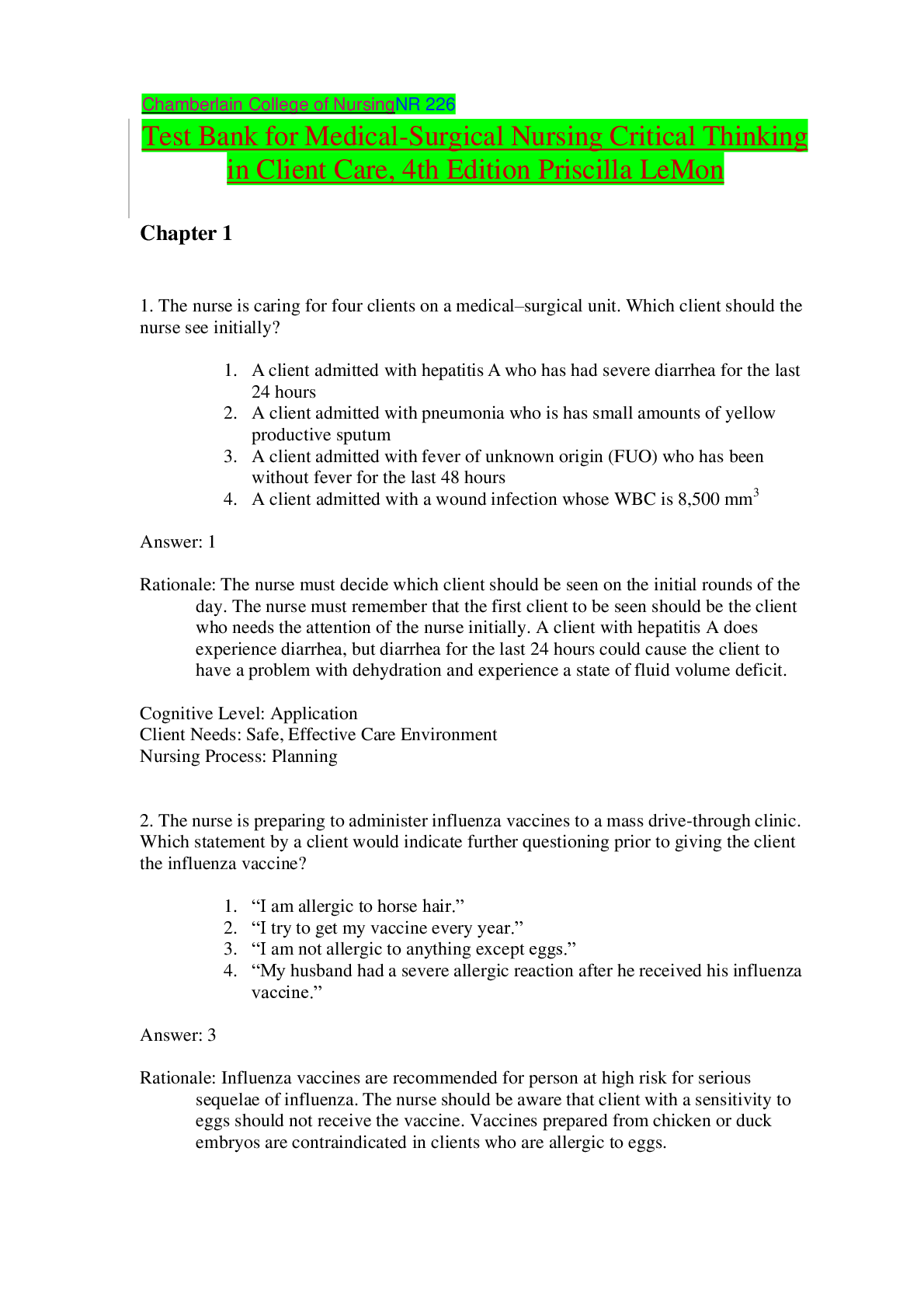
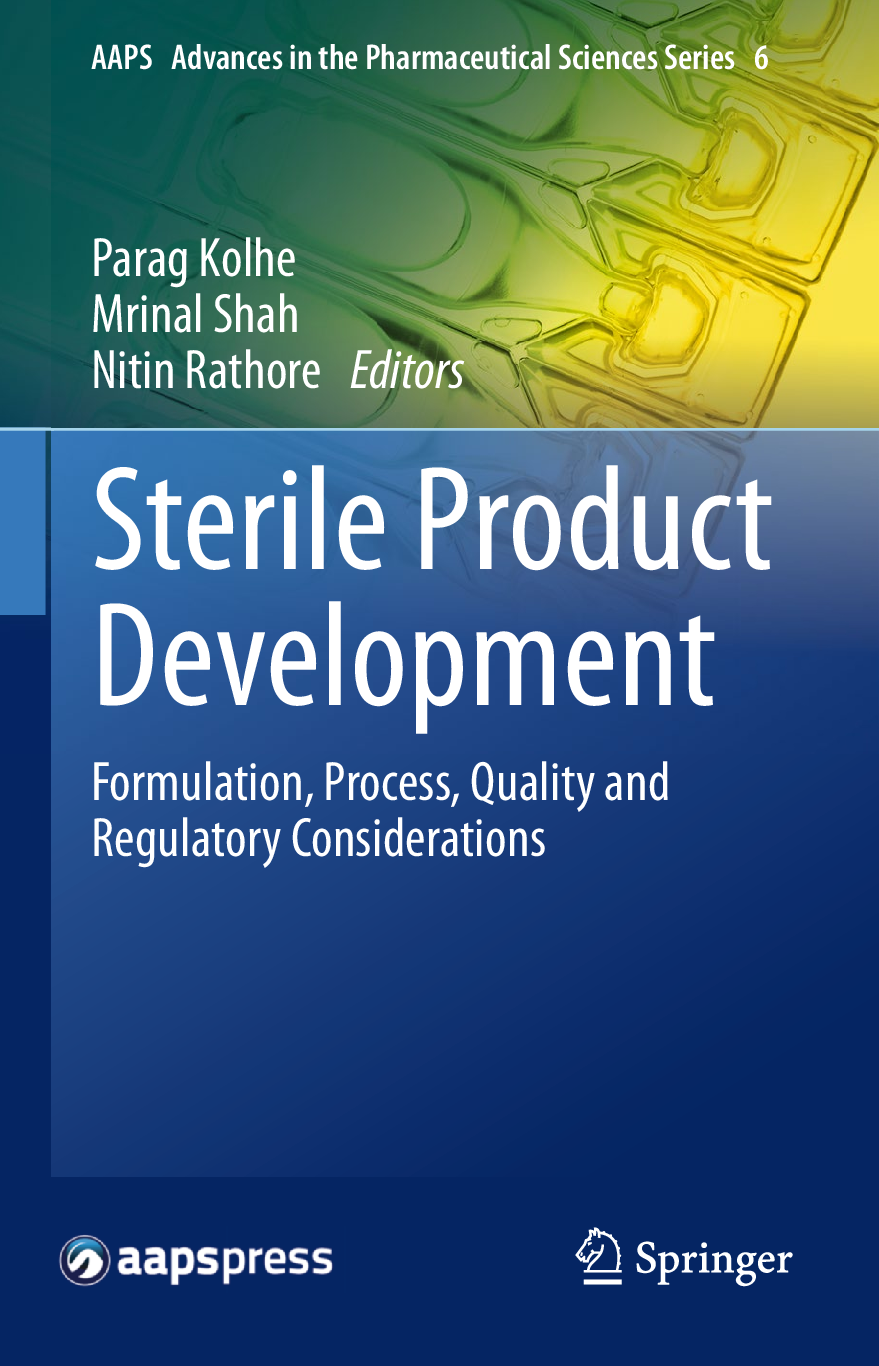
.png)
.png)


.png)
.png)
.png)
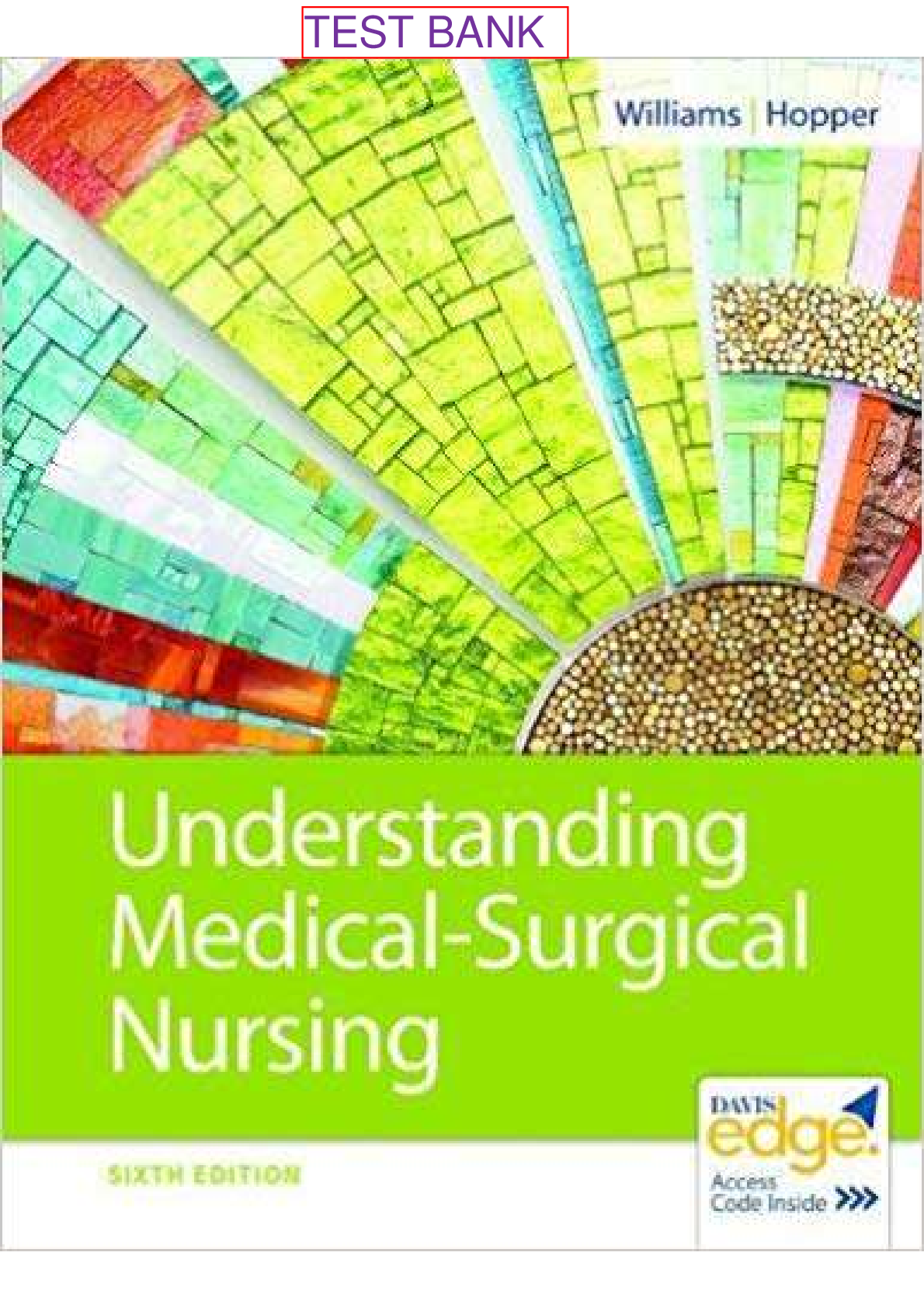
.png)
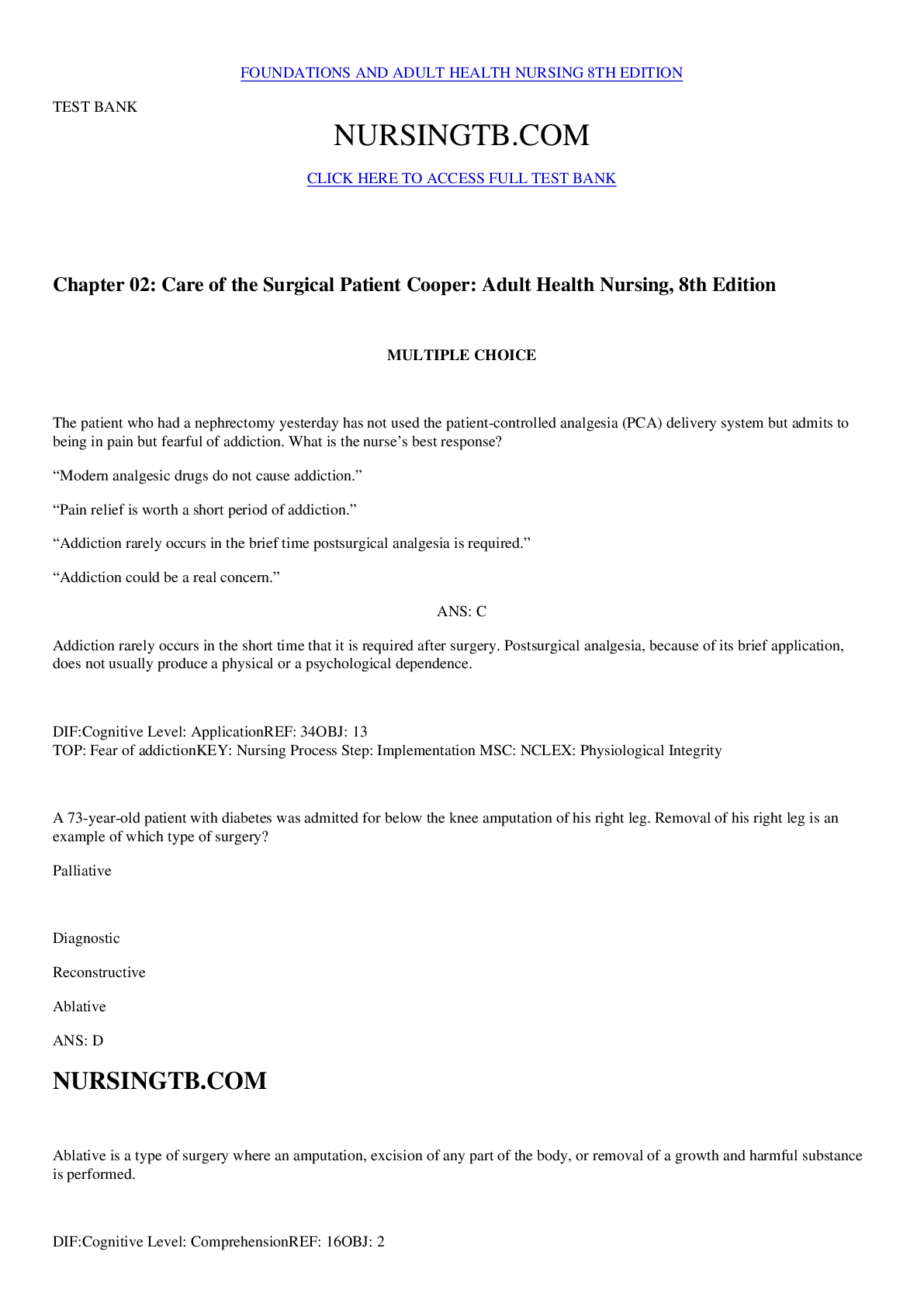
.png)
.png)
